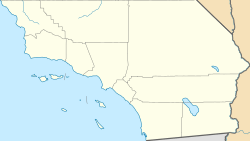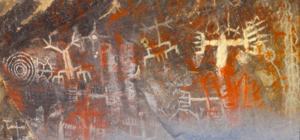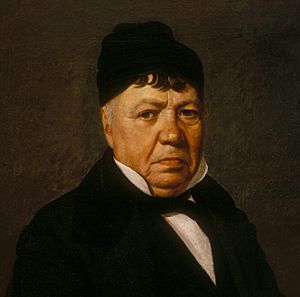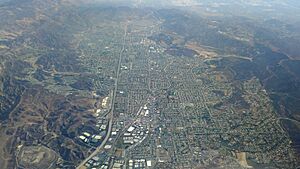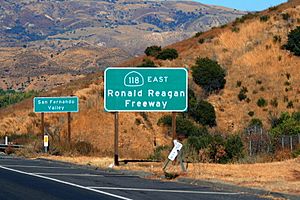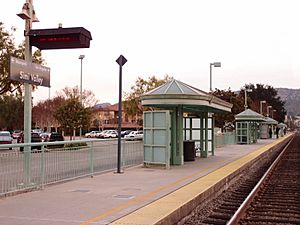Simi Valley, California facts for kids
Quick facts for kids
Simi Valley, California
|
|||
|---|---|---|---|
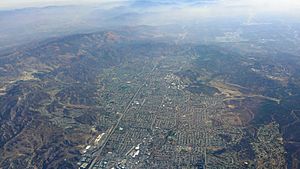
Aerial view of Simi Valley in 2014
|
|||
|
|||
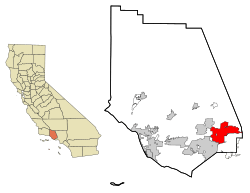
Location in Ventura County and the state of California
|
|||
| Country | United States | ||
| State | California | ||
| County | Ventura | ||
| Incorporated | October 10, 1969 | ||
| Government | |||
| • Type | Council-Manager | ||
| • Body | City council: Dee Dee Cavanaugh Mike Judge Elaine P. Litster |
||
| Area | |||
| • Total | 42.25 sq mi (109.43 km2) | ||
| • Land | 41.54 sq mi (107.60 km2) | ||
| • Water | 0.71 sq mi (1.83 km2) 1.81% | ||
| Elevation | 768 ft (234 m) | ||
| Population
(2020)
|
|||
| • Total | 126,356 | ||
| • Rank | 3rd in Ventura County 48th in California |
||
| • Density | 2,990.7/sq mi (1,154.67/km2) | ||
| Time zone | UTC−8 (Pacific) | ||
| • Summer (DST) | UTC−7 (PDT) | ||
| ZIP Codes |
93062, 93063, 93064, 93065, 93093, 93094, 93099
|
||
| Area code | 805/820 | ||
| FIPS code | 06-72016 | ||
| GNIS feature IDs | 1661450, 2411904 | ||
Simi Valley is a city in the southeast part of Ventura County, California. It's located in a valley with the same name. Simi Valley is about 40 miles from Downtown Los Angeles. This makes it part of the larger Greater Los Angeles Area. The city is next to Thousand Oaks, Moorpark, and the Chatsworth area of Los Angeles.
In 2020, about 126,356 people lived here. Simi Valley is surrounded by the Santa Susana Mountains and the Simi Hills. It's west of the San Fernando Valley and northeast of the Conejo Valley. The city grew as a place where people could live and travel to work in Los Angeles. This happened after a freeway was built over the Santa Susana Pass.
The Ronald Reagan Presidential Library is in Simi Valley. This is where Ronald Reagan, a former president, was buried in 2004.
Contents
- Discovering Simi Valley's Past
- Exploring Simi Valley's Geography
- People and Population in Simi Valley
- Important Places in Simi Valley
- Getting Around Simi Valley: Infrastructure and Transportation
- Simi Valley's Economy and Jobs
- Learning in Simi Valley: Education and Libraries
- Fun and Outdoors: Parks and Recreation
- Wildlife in Simi Valley: Animals and Nature
- Famous People from Simi Valley
- Images for kids
- See also
Discovering Simi Valley's Past
Early Inhabitants: The Chumash People

Simi Valley was first home to the Chumash people. They lived in this area for thousands of years. The Chumash also lived in many other parts of California. About 5,000 years ago, they started using acorns for food. They also gathered plants from marshlands.
Around 2,000 years later, their hunting and fishing skills got better. This caused the population to grow a lot. The Chumash people in Simi Valley spoke a special language. It was called Ventureño, a type of Chumash.
The name Simi Valley comes from the Chumash word Shimiyi. This word describes the thin, cloud-like mists often seen in the area. These mists come from coastal fog. They move into the Oxnard Plain and then into Simi Valley.
During the Mission period (late 1700s to early 1800s), three Chumash villages were in Simi Valley. These were Shimiyi, Ta'apu (now Tapo Canyon), and Kimishax. You can find many Chumash cave paintings in the area. These paintings are called pictographs. One famous spot is the Burro Flats Painted Cave. It's located in the Simi Hills. This cave is on private land owned by NASA. Other Chumash paintings are near Lake Manor and Chatsworth.
Spanish Land Grants: The Rancho Period
The first Europeans to visit Simi Valley were Spanish explorers. This was in 1770. They traveled through the valley on their way to the San Fernando Valley. They camped near a native village.
Rancho Simí was a very large Spanish land grant. It covered about 113,000 acres. It was given in 1795 to Santiago Pico. After he passed away, his sons received the land. Rancho Simí was the first Spanish land grant in Ventura and Santa Barbara Counties. It was one of the biggest in California. The Simi Adobe-Strathearn House was the main building for the rancho.
In 1842, José de la Guerra y Noriega bought Rancho Simí. He was a captain from the Santa Barbara Presidio. He bought a lot of land in California to raise cattle. After his death in 1858, his sons continued to run the ranches. But droughts in the 1860s caused them to lose much of their land. By the 1880s, the De la Guerra family no longer owned the rancho.
American Settlers: The Pioneer Period
The 'American' period in Simi Valley began when Thomas Alexander Scott bought Rancho Simí in 1865. He was an investor from the east. He hoped to find oil on the land. Soon, Thomas Bard was sent to manage Scott's properties in California.
In the late 1880s, the Simí Land and Water Company was formed. They started selling parts of the large rancho. American farmers began to lease land for farming. Charles Emerson Hoar was one of the first American farmers. He raised sheep, which was a good way to make a living back then.
Most of the Simí Rancho land was used for raising sheep, cattle, and grain. Wheat and barley were important crops. Farming and ranching were the main activities until the 1950s. Citrus fruits, walnuts, and apricots were also grown. In the early 1960s, modern homes started to be built.
Growth of Simi Valley: Modern Development
Simi Valley was mostly farms and ranches. There were also four small communities. The first "tract" homes were built in 1957 and 1958. But the biggest growth happened after 1960. The population doubled from 4,073 in 1950 to 8,110 in 1960. By 1970, the population was 59,832.
Before modern development, there were four main communities:
- Simi – In 1888, the Simi Land and Water Company divided the rancho into farms. A group of investors bought land and planned a town called 'Simiopolis'. They brought pre-cut houses from Chicago by train. This was the first neighborhood in Simi. Stores opened, and the first school was built in 1890.
- Santa Susana – The Santa Susana Train Depot was built in 1903. A small business area grew near the depot. Over time, homes were built, and the town of Santa Susana was formed. The depot was moved in 1975 to its current location.
- Community Center – This area was planned in 1922. It grew because a high school and a central elementary school were needed. Simi High School's first class graduated in 1924. Many houses were built here in the 1920s and 1930s.
- Mortimer Park (Susana Knolls) – This area was bought in the 1920s for vacation cabins. The lots were very small. In 1944, the name was changed to Susana Knolls.
In 1969, residents voted to make the towns of Simi, Community Center, and Santa Susana one city. They chose the name 'Simi Valley' over 'Santa Susana'. Susana Knolls is still a separate, unincorporated area.
Historical Sites and Events
Santa Susana Field Laboratory's Role
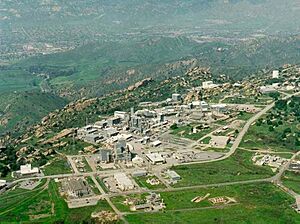
The Santa Susana Field Laboratory is a large area in the Simi Hills. It was used for developing nuclear reactors and rocket engines. This started in 1948. Rocket engine tests were often heard in Simi Valley.
One part of the lab, Atomics International, built and ran the Sodium Reactor Experiment. In 1957, this became the first U.S. commercial nuclear reactor to provide electricity to a public power system. It powered the city of Moorpark. The last nuclear reactor worked there in 1980. The last rocket engine was made in 2006. The site is now closed for testing. It is being cleaned up by The Boeing Company, the U.S. Department of Energy, and NASA.
The Santa Susana Field Laboratory also has important historical sites. These include the Burro Flats Painted Cave. This cave has some of the best-preserved Native American drawings in Southern California.
The Rodney King Trial in Simi Valley
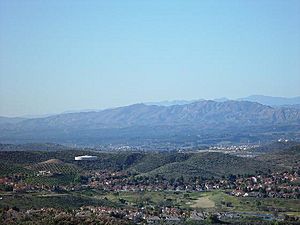
In 1992, a famous trial took place in Simi Valley. Four police officers from Los Angeles were accused of using too much force. This happened during the arrest of Rodney Glen King in 1991. A bystander recorded the event on video. This video was shown everywhere.
Because of all the media attention, the trial was moved to Simi Valley. On April 29, 1992, the jury made its decision. Three officers were found not guilty. The jury could not agree on a verdict for the fourth officer. Many people were surprised by this outcome. The jury included ten white people, one Filipino person, and one Hispanic woman. None of them lived in Simi Valley. This decision led to protests and riots in Los Angeles.
Exploring Simi Valley's Geography
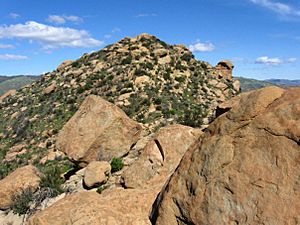

Simi Valley is in the very southeast part of Ventura County. It borders the San Fernando Valley in Los Angeles County. The city is mostly within the valley itself. To the north are the Santa Susana Mountains. To the east and south are the Simi Hills. Thousand Oaks is to the southwest, and Moorpark is to the west.
Simi Valley is connected to the San Fernando Valley by the Santa Susana Pass. This pass is in the far east of Simi Valley. The city's elevation is between 700 and 1,000 feet above sea level. The valley is shaped by the way the rocks have folded and faulted over time. It is drained by the Calleguas Creek and Conejo Creek. These creeks start in the Santa Susana Mountains.
The city covers about 42.2 square miles. Most of this is land. Simi Valley is about 30 miles from Downtown Los Angeles. People often travel to Los Angeles using California State Route 118 (Ronald Reagan Freeway). They can also use the Metrolink commuter train.
Simi Valley's Climate and Weather
| Humidity (%) | ||
| High | Low | |
| Jan. | 70 | 50 |
| Apr | 50 | 35 |
| Jul. | 50 | 38 |
| Oct. | 75 | 45 |
| Annual | 61 | 42 |
Simi Valley has a warm and dry climate in summer. Mean temperatures are usually in the 70s. Wildfires can happen during this time. In winter, the climate cools, with mean temperatures in the 50s. Snow is very rare in the Simi Hills.
The warmest month is August, with an average high of 96°F. The coldest month is December, with an average low of 38°F. Temperatures can change a lot between day and night in summer. The average yearly rainfall is about 18 inches. Winter months get more rain than summer months. February is the wettest month, with about 4.8 inches of rain.
Simi Valley gets about 277 sunny days each year. The highest temperature ever recorded was 116°F in August 1985. The lowest was 18°F in February 1989.
Natural Challenges: Earthquakes and Wildfires
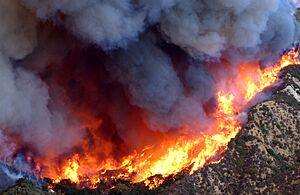
Simi Valley is in an area that can experience wildfires. These fires sweep through Southern California's mountains every few years. The city is also at risk for earthquakes. There are several fault lines nearby. In 1994, parts of Simi Valley were damaged by the 1994 Northridge earthquake.
Wildfires in the Simi Hills
In autumn 2003, the Simi Fire burned about 108,000 acres. Another fire in 2005 started on September 28. It burned around 7,000 acres. The next day, it grew to about 17,000 acres. Over 1,000 firefighters worked to control it. They faced dry brush, low humidity, and hot temperatures. The fire was eventually put out. Only three homes in outlying areas were lost.
People and Population in Simi Valley
| Historical population | |||
|---|---|---|---|
| Census | Pop. | %± | |
| 1970 | 59,832 | — | |
| 1980 | 77,500 | 29.5% | |
| 1990 | 100,217 | 29.3% | |
| 2000 | 111,351 | 11.1% | |
| 2010 | 124,237 | 11.6% | |
| 2020 | 126,356 | 1.7% | |
| U.S. Decennial Census | |||
| Historical racial profile | 2020 | 2010 | 2000 | 1990 | 1980 |
|---|---|---|---|---|---|
| White | 60.0% | 75.3% | 81.3% | 88.2% | 92.5% |
| —Non-Hispanic (NH) | 54.0% | 62.8% | 72.7% | 79.9% | 86.2% |
| Black or African American (NH) | 1.5% | 1.3% | 1.2% | 1.5% | 1.1% |
| Hispanic or Latino (of any race) | 28.4% | 23.3% | 16.8% | 12.7% | 9.3% |
| Asian (NH) | 10.5% | 9.1% | 6.2% | 5.3% | - |
| American Indian (NH) | 0.2% | 0.3% | 0.4% | 0.5% | - |
| Other (NH) | 5.4% | 3.2% | 2.7% | 0.1% | 3.4% |
Simi Valley's population has grown a lot over the years. In 2020, the total population was 126,356. The city has become more diverse. The percentage of people who identify as non-Hispanic white has decreased. It went from 86.2% in 1980 to 54% in 2020.
Population Details from 2010
| Ancestry in Simi Valley | ||||
|---|---|---|---|---|
| Origin | percent | |||
| German American | 16.7% | |||
| Mexican American | 16.2% | |||
| English American | 11.3% | |||
| Italian American | 8.5% | |||
| Multiracial American | 4.6% | |||
| French American | 3.4% | |||
| Polish American | 3.1% | |||
| Indian American | 2.7% | |||
| Norwegian American | 2.3% | |||
| Swedish American | 2.3% | |||
| Filipino American | 2.2% | |||
| Scottish American | 2.1% | |||
| Dutch American | 2.0% | |||
| Other | 22.6% | |||
In 2010, Simi Valley had 124,237 people. About 75.3% were White. 9.3% were Asian, and 8.6% were from other races. About 23.3% of the population was Hispanic or Latino. The largest groups of white residents were German-American (16.7%) and English (11.3%).
Most people (99.5%) lived in households. About 40.7% of households had children under 18. The average household had 3 people. The average family had 3.33 people. The median age in Simi Valley was 37.8 years. About 25% of the population was under 18.
Income and Living in Simi Valley
In 2022, the average household income in Simi Valley was $112,144. About 7.02% of the population lived below the poverty line. The median cost of homes was $704,200. The unemployment rate was 4.10%.
Important Places in Simi Valley

Simi Valley is home to the Ronald Reagan Presidential Library. This library is a popular place to visit. Almost 400,000 people visited it in 2014. After his state funeral, President Reagan was buried at the library in June 2004.
The library has a large hangar. Inside, you can see the Boeing 707 Air Force One plane. This plane was used by presidents from Nixon to G.W. Bush. You can also see cars and a helicopter used by the president. The presidential library often hosts events and debates.
Getting Around Simi Valley: Infrastructure and Transportation
A railroad line, the Montalvo Cutoff, runs through the valley. It was opened in 1904. In 1905, the longest train tunnel in the U.S. at that time was finished. This tunnel connects Simi Valley and the San Fernando Valley. The Santa Susana Depot was built in 1904. It was used for passengers and freight for 60 years.
Today, the Simi Valley station is used by Amtrak and Metrolink trains. These trains connect Simi Valley to Santa Barbara and San Luis Obispo to the north. They also go south to Los Angeles and other counties. Buses from Simi Valley Transit also stop at the station. Trains and buses run every day.
The United States Postal Service has several post offices in Simi Valley. The city has its own police department. The Ventura County Fire Department provides fire protection. There are six fire stations in the city. Emergency medical services are also provided. The city manages its own sanitation services. This includes collecting and treating sewage and wastewater.
Simi Valley's Economy and Jobs
About 27% of Simi Valley residents travel to Los Angeles for work. Another 20% work within Simi Valley itself. The city has two main industrial areas. One is in the east, and the other is in the west. The biggest industries are machinery and tools, and the metal industry. Other industries include lumber, food, plastic products, and textiles.
Countrywide Home Loans, now part of Bank of America, has a large office in Simi Valley. It used to employ about 10,000 people in the city. The Volkswagen of America Design Center was once here too. It moved to Santa Monica in 2006.
Top Employers in Simi Valley
The biggest employers in Simi Valley include:
| # | Employer | # of employees |
|---|---|---|
| 1 | Simi Valley Unified School District | 1,991 |
| 2 | Adventist Health, Simi Valley | 1,078 |
| 3 | Aerovironment, Inc. | 875 |
| 4 | Meggitt Safety Systems, Inc. | 580 |
| 5 | City of Simi Valley | 486 |
| 6 | Milgard Windows & Doors | 477 |
| 7 | Rancho Simi Parks & Recreation District | 328 |
| 8 | Entertainment Earth | 225 |
| 9 | Polytainer, Inc. | 164 |
| 10 | Vista Professional | 130 |
Learning in Simi Valley: Education and Libraries
Simi Valley is served by the Simi Valley Unified School District (SVUSD). Santa Susana High School has been recognized as one of the "Top 500 Schools in America." Simi Valley High School was also ranked among the "Top 1,000 High Schools" in the country.
There are five high schools in Simi Valley:
- Royal High School
- Grace Brethren High School
- Santa Susana High School
- Simi Valley High School
- Apollo High School (a continuation school)
The city also has three middle schools: Hillside Middle School, Valley View Middle School, and Sinaloa Middle School. Simi Valley has an adult school and a cosmetology school.
Many colleges and universities are located nearby. These include Moorpark College, Cal State Northridge, and California Lutheran University.
Simi Valley Public Library
The Simi Valley Public Library opened in July 2013. It is run by the City of Simi Valley. Before this, library services were part of the Ventura County Library system. In its first year, over 200,000 people visited the library.
Fun and Outdoors: Parks and Recreation
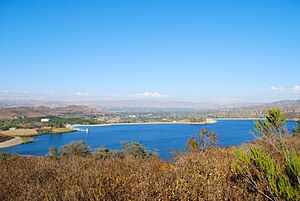
The Rancho Simi Recreation and Park District manages parks in Simi Valley. There are 50 parks in total. Some are city parks, while others are open spaces or trail systems. The district owns about 5,600 acres of public land. This includes hundreds of acres in the Simi Hills. These areas help protect the natural landscape and wildlife.
Simi Valley also has six golf courses. The Kanan Ranch home development has nature trails for hikers, bicyclists, and horse riders. Two college baseball teams, the Simi Valley Senators and the California Oaks, play nearby.
Exploring Trails and Open Spaces
To the east, Rocky Peak has a trail system for mountain biking, hiking, and horseback riding. You can access these trails from the 118 freeway. Some trails, like the Hummingbird Trail, are quite steep.
To the southwest, there are many trails for outdoor activities. The main entrance for Wood Ranch Open Space is at Wood Ranch Parkway and Long Canyon Parkway. These trails connect to other systems like Lang Ranch and Chesebro. Simi Peak, the highest point in Simi Valley, can be reached from this trail system. The west end of Simi Valley also has the 150-acre Tierra Rejada Park. It offers hiking trails to nearby Moorpark.
Ice Skating and Sports
To the west is the Iceoplex. It's an ice skating facility with Olympic and NHL-sized rinks. It's home to several hockey teams. These include the Ventura Mariners, the Cal State Northridge Matadors club hockey program, and the Ventura County Poseidon.
List of Public Parks
- Arroyo Park
- Arroyo Simi Trail
- Arroyostow Park
- Atherwood Park
- Berylwood Park
- Big Sky Park
- Challenger Park
- Chumash Park
- Citrus Grove Park
- Corriganville Park
- Coyote Hills Park
- Darrah Park
- Foothill Park
- Frontier Park
- Houghton-Schreiber Park
- Indian Hills Open Space
- Knolls Park
- Las Llajas Canyon
- Lincoln Park
- Marr Ranch Open Space
- Mayfair Park
- Mount McCoy
- Mount Sinai
- Oak Park
- Old Windmill Park
- Parker Ranch Open Space
- Rancho Madera Park
- Rancho Santa Susana Community Park
- Rancho Simi Community Park
- Rancho Tapo Community Park
- Rocky Peak Park
- Sage Ranch Park
- Sand Canyon Open Space
- Santa Susana Park & Historic Railroad Depot
- Sequoia Park
- Simi Hills Park
- Simi Peak
- Sinaloa Park
- Stargaze Park
- Strathearn Historical Park and Museum
- Sycamore Canyon Park
- Sycamore Park
- Tapo Canyon Regional Park
- Tierra Rejada Park
- Verde Park
- Vista Del Arroyo Park
- Willowbrook Park
- Wood Ranch Open Space
Wildlife in Simi Valley: Animals and Nature

The Simi Hills are a very important wildlife corridor. They connect the Santa Monica Mountains to the Santa Susana Mountains and other ranges. This helps protect large land animals from being isolated. Many parts of the Simi Hills are protected parks and open spaces.
Animals in the area include mammals like Virginia opossums, mountain lions, mule deer, bobcats, and coyotes. You can also find different types of skunks, badgers, raccoons, and foxes. There are many kinds of mice, rats, and bats too.
Reptiles in Simi Valley include several types of snakes. These are southern Pacific rattlesnakes, San Diego gopher snakes, and California kingsnakes. Lizards like the western fence lizard and San Diego alligator lizard also live here. Ten types of amphibians are found in Simi Valley. These include the California newt, California toad, and Pacific treefrog.
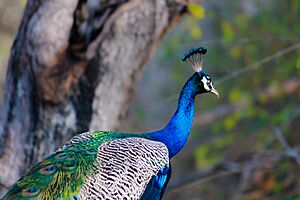
Many birds live in Simi Valley. You can see Anna's hummingbirds, Canada gooses, mallards, and California quails. Other birds include common ravens, crows, and mockingbirds. Raptors like turkey vultures, American kestrels, and different types of hawks and owls are also present. You might also spot finches and sparrows. Wild peacocks live near the canyons of Santa Susana Knolls.
Famous People from Simi Valley
Many notable people have connections to Simi Valley:
- Dallas Braden, Major League Baseball player
- Mike Mo Capaldi, professional skateboarder
- Francis Chan, pastor and author
- Jason Dolley, actor
- Joey King, actress
- Don MacLean, UCLA and NBA player
- Merrell Twins, YouTubers and musicians
- Torey Pudwill, professional skateboarder
- Scott Radinsky, Major League Baseball player and singer
- Danielle Savre, actress and singer
- Shailene Woodley, actress
Images for kids
-
Panoramic skyline of Simi Valley from its western end, Tierra Rejada Park, with bordering Simi Hills in the far-background to the north, south, and east
See also
 In Spanish: Simi Valley (California) para niños
In Spanish: Simi Valley (California) para niños




